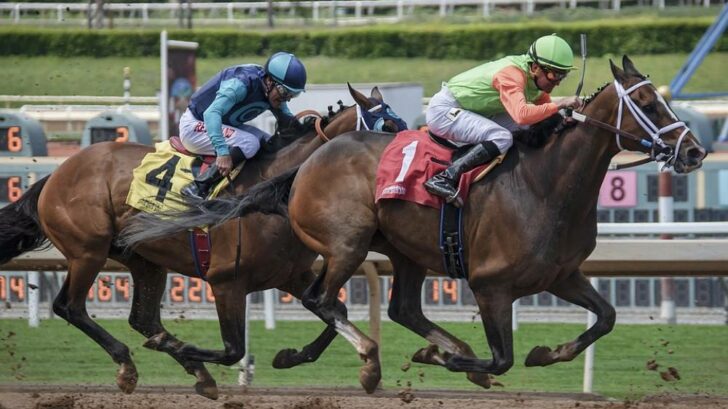Horse Racing History – Its Evolution and Effortless Growth

Introduction: Horse Racing History – Its Evolution and Effortless Growth
When it comes to all sports, probably football is the most popular one in the world. But if we’re talking about sports betting then there’s no doubt that horse racing is number one. Though cricket, basketball, tennis, soccer and other jackpot games all see huge amounts of money wagered on them every week, nothing comes close in terms of the interest and enthusiasm for betting on the horses.
Though you can wager on horse racing by simply going online and finding a sportsbook, many people say that to do it properly means attending a horse race, as this is part and parcel of the whole betting experience. Dressing up to the nines is mandatory if you really want to be part of the whole glitz and glamour associated with the sport. One question that many ask is how did horse racing become so popular and reach the point where so many people bet on the sport? To answer that, let’s have a dive into the remarkable journey that horse racing history has taken from ancient times to the modern era.
The Horse Racing History
The competitive racing of horses has probably taken place over the course of many thousands of years since humans first domesticated animals. Some historians believe that man has been racing horses since 4500 BC when they were nomadic tribespeople. According to horse racing history, we do know for a fact that the Romans of Ancient Rome enjoyed both horse and chariot racing and, according to horse racing history, these formed an important part of their culture and games. The ancient Greeks also enjoyed both forms of horse racing and these sports played an important part in the ancient Olympic Games.
We can thank the English Crusaders of the 12th century who returned from the Holy Lands bringing Arab thoroughbred horses, and in doing so started what was to become modern horse racing history. Over the next 400 years, the aristocracy selectively bred these Arab stallions with English mares and was able to produce horses of increased stamina that were capable of running for sustained periods of time. As these horses were tested by racing against each other it became a common occasion for the aristocracy to meet up.
These meetings were often lavish events, befitting the aristocracy who were organising them. Throughout horse racing history, the activity was seen as a noble sport and even today is known as the “Sport of Kings.”
Horse Racing History: The Birth of Modern Horse Racing

Horse racing first became a professional sport during the early 18th century. These first races were typically what were called “match races” and involved two horses running head to head. But as more people became involved in racing, then these races evolved into multi-horse competitions. Thanks to a huge interest in horse racing by the public, before long, many racecourses sprung up all over England. It goes without saying that the more venues were opened, then the bigger the prizes to attract both owners and jockeys, as well as encouraging the public about how to win the jackpot with bigger and bigger wagers.
In 1750, in the English town of Newmarket, the Jockey Club was formed as a means to control the growth and popularity of horse racing and quickly became the sports governing body. This was a significant event in horse racing history. As the governing body of all horse racing, the Jockey Club set the rules to ensure that there was a level playing field throughout the sport. These rules and regulations covered all aspects of horse racing and they included the racecourses, wagering rules, types of bets, how people should behave, jockey colours, and also how horses should be bred.
Thanks to their horse racing history efforts, today we can look at the General Stud Book which documents every thoroughbred horse in racing history going back to 1791. In fact, all horses that are racing today can be traced back to one of three original stallions. At the height of the British Empire, Britain began to export horse racing to other colonies along with cricket, football, and rugby.
The story of horse racing in the Americas begins in earnest in 1665 when the first proper racecourse was built on Long Island. According to horse racing history, though horse racing was popular among the local people, it wasn’t until 1868 that the sport became nationally popular. This was the year that the Americans produced their own version of a horse breeders record, called The Stud Book. Over the course of the following 20 years, 314 race tracks opened across to the US. In order to set rules and standards, in 1894 the American Jockey Club was formed in New York. This was to be the US sports governing body and worked in a similar way to the UK Jockey Club.
Horse racing History: Betting on Horses
Betting on horses is one form of wagering that has a long history. Since the English aristocracy and nobility were breeding their own horses, they were also holding races and wagering on the outcomes. In the early 18th century the sport was attracting huge numbers of spectators and they began placing bets at the racecourse, and in a form of self-fulfilling prophecy, the money that these spectators were spending on the sport would go on to ensure larger prizes for the owners and jockeys, which in turn drove a boom in horse racing and breeding.
In the USA as a sport rapidly became popular, so did betting on it. During the early part of the 20th century, anti-gambling laws spread across the country and this led to the prohibition of all bookmaking to the point that the sport struggled to exist. From 314 racetracks that existed in 1900, only 25 were to remain open over the following 8 years. It was during this period that the pari-mutuel betting system was set up at the Kentucky Derby.
It’s interesting to speculate on the reasons why betting on horses is so popular. In horse racing, there is a correlation between the legality and popularity of the sport in relation to the outcome of the races. Because each individual horse race is much shorter than many other sports, including football, basketball, or tennis, then the betters don’t have to wait such a long time to discover the results and see whether they have won anything. When it comes to betting on horses, we love 22Bet Sportsbook. They have a great welcome bonus of 122% of up to €100.
In the casino setting, we could compare horse racing with jackpot slots machines, which are by far the most popular jackpot games in the whole gambling establishment and certainly generate the most revenues worldwide. It has a similarity to horse racing thanks to the unpredictable outcomes, the varied risk, and the simplicity of the whole experience. Another popular driving force behind horse racing is the tipsters who have created a whole industry dedicated to giving horse racing betting tips to punters who hope that these jackpot winning strategies actually work.
Horse Racing History: The Economic Contribution

The pari-mutuel betting system can be found in both the USA and the UK and gives a percentage of the total amount wagered to the race track. Typically this is between 14% and 25% of the total amount bet on each race. All this amounts to more than $11 billion being spent on bets every year in the United States. Of this, $2.75 billion dollars is the annual revenue for racecourses. From this, it’s clear that the success of horse racing is directly correlated to the amounts being wagered. Head over to 22Bet Sportsbook to place your horse racing bets.
Conclusion: Horse Racing History – Its Evolution and Effortless Growth
Over the last 6,000 years, horse racing history has enjoyed mixed fortunes but the biggest influence that has impacted the sport is the change in the gambling environment that has been created over the last couple of hundred years. As long as horse racing fans are able to place wages, then the sport can continue to exist and grow. We have a useful list of horse racing terms here.














